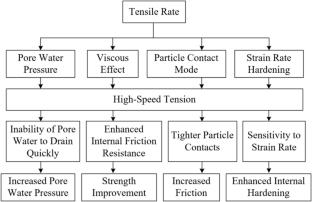Key influencing factors and prediction model for the tensile strength of compacted clayey loess
Abstract
The tensile strength of loess directly impacts the stability and safety of engineering constructions in loess regions. To systematically investigate the key factors influencing the tensile strength of compacted loess, uniaxial tensile tests were conducted on loess samples using a self-developed high-precision uniaxial testing apparatus. The effects of saturation and tensile rate were analyzed, and a mathematical model was developed to predict the tensile strength of compacted loess. Additionally, the dynamic tensile behavior of loess under stepwise loading was studied to examine the rate effect. The microstructural characteristics of clayey loess at different moisture contents were also explored to help explain the underlying mechanisms. The results showed that the relationship between saturation and tensile strength in clayey loess is asymmetric. Water’s influence on clayey loess is not only related to capillary suction but also to the hydration of the clay particles. The relationship between tensile rate and tensile strength exhibited a nonlinear enhancement: the higher the rate, the slower the increase in tensile strength. As the tensile rate increased, the stress–strain curve of the soil exhibited more brittle fracture characteristics. Under stepwise tensile conditions, the tensile rate in the second stage was negatively correlated with the ultimate tensile strain. Based on the experimental results, a reliable prediction model was established to forecast the tensile strength of compacted loess under various key influencing factors. These findings provide theoretical insights for engineering design and soil improvement technologies in loess regions.


 求助内容:
求助内容: 应助结果提醒方式:
应助结果提醒方式:


